#Jerusalem bureau
Text
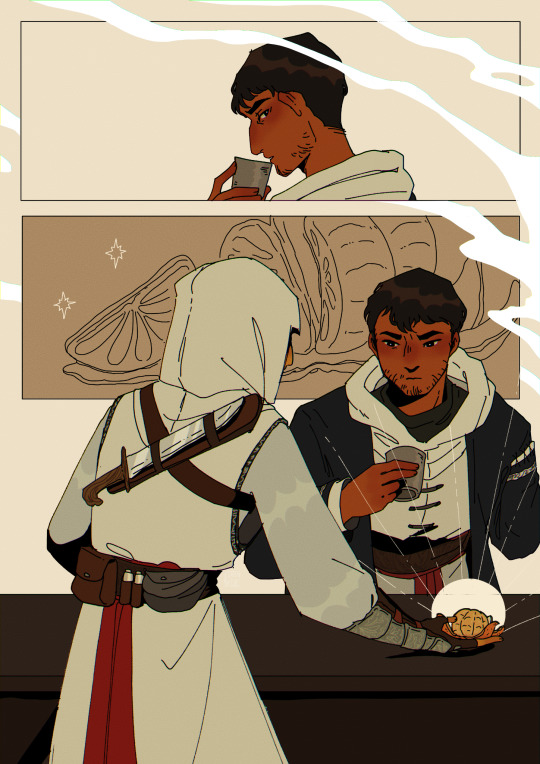
bitter tea & oranges
sequel -> tea & dates
#inspired by the amount of time i spent just standing in jerusalem bureau#and my hc that malik would drink bitter medicinal teas to help with chronic pain#also my hc is that altair has chronic pain. so hes familiar how to deal with it#sort of a peace offering to offer orange to counteract the bitter tea#peeling oranges as an act of love ok ty#THIS WAS SUPPOSED TO BE A WARM UP the ghost of altair possessed me to draw malik lovingly#my art#asscreed#assassin's creed 1#assassins creed 1#assassins creed#assassin's creed#altair ibn la'ahad#altaïr ibn la'ahad#malik al sayf#altmal#ac1#ac#ac 1#i will never shut up about jerusalem bureau being my safe place rn#altaïr visiting malik. he can scold me however much he wants. atleast he still sees me as someone worth talking to#maliks hatred recognising altair as his own existence vs al mualims adoration of altair like a well kept weapon
1K notes
·
View notes
Text

#News#cnn#idf#israel#democrats#republicans#politics#gaza#gaza strip#woc#poc#women of color#muslims#jerusalem#genocide#journalism#usa
16K notes
·
View notes
Text
CNN is facing a backlash from its own staff over editorial policies they say have led to a regurgitation of Israeli propaganda and the censoring of Palestinians perspectives in the network’s coverage of the war in Gaza.
Journalists in CNN newsrooms in the US and overseas say broadcasts have been skewed by management edicts and a story-approval process that has resulted in highly partial coverage of the Hamas massacre on 7 October and Israel’s retaliatory attack on Gaza.
“The majority of news since the war began, regardless of how accurate the initial reporting, has been skewed by a systemic and institutional bias within the network toward Israel,” said one CNN staffer. “Ultimately, CNN’s coverage of the Israel-Gaza war amounts to journalistic malpractice.”
According to accounts from six CNN staffers in multiple newsrooms, and more than a dozen internal memos and emails obtained by the Guardian, daily news decisions are shaped by a flow of directives from the CNN headquarters in Atlanta that have set strict guidelines on coverage.
They include tight restrictions on quoting Hamas and reporting other Palestinian perspectives while Israel government statements are taken at face value. In addition, every story on the conflict must be cleared by the Jerusalem bureau before broadcast or publication.
10K notes
·
View notes
Text
If you get your news from CNN, please know they've been compromised and do in fact aid Israel in the way they provide coverage.!!!!
Their coverage is curated specifically to garner sympathy for Israel and to provide plausibile deniability for their war crimes such as genocide. Links below the vid.
Additionally, the breach to freedom of press this implies should NOT be understated.
“‘War-crime’ and ‘genocide’ are taboo words,” the worker said. “Israeli bombings in Gaza will be reported as ‘blasts’ attributed to nobody, until the Israeli military weighs in to either accept or deny responsibility. Quotes and information provided by Israeli army and government officials tend to be approved quickly, while those from Palestinians tend to be heavily scrutinized and slowly processed.”
CNN maintains that the reason for the policy is to ensure its reporting on Israel and Palestine is “as precise and accurate as possible,” as one spokesperson said, claiming that the IDF’s censor has a “minimal” impact on the coverage. But CNN seems to be unique in maintaining this policy, unlike other major outlets, The Intercept wrote.
Further, the investigation found that CNN leaders have explicitly prescribed policies that favor Israel.
In an email sent October 26, CNN’s News Standards and Practices sent staff an email directing them to refer to the ministry of health in Gaza as “Hamas-controlled” every time they reference the Palestinian death count — a widespread practice among major outlets, despite numerous human rights groups and war experts maintaining that the Gaza health ministry’s death tolls have historically been accurate and that public health experts have independently found no evidence that the ministry has inflated death counts.

#cnn#news#israel#idf#palestine#free palestine#gaza#Zionism#zionist propaganda#propaganda#media campaign#israel media#Democrats#republicans#usa#fascism#censorship#media censorship#state power#equality#justice#current events#current news#middle east#iof#from the river to the sea#media coverage#signal boost#reblog#vote blue
814 notes
·
View notes
Text
During an appearance at Vassar College in early February, controversial New York Times Jerusalem bureau chief Ethan Bronner was asked about the ongoing evictions of Palestinian families from homes in East Jerusalem which Israel occupied in 1967. Israeli courts have ruled that Jewish settlers could take over some Palestinian homes on the grounds that Jews held title to the properties before Israel was established in 1948.
Bronner was concerned, but not only about Palestinians being made homeless in Israel’s relentless drive to Judaize their city; he was also worried about properties in his West Jerusalem neighborhood, including the building he lives in, partially owned by The New York Times, that was the home of Palestinians made refugees in 1948. Facts about The New York Times’ acquisition of this property are revealed for the first time in this article.
“One of the things that is most worrying not just the Left but a lot of people in Israel about this decision is if the courts in Israel are going to start recognizing property ownership from before the State [of Israel was founded],” Bronner said according to a transcript made by independent reporter Philip Weiss who maintains the blog Mondoweiss.net.
Bronner added, “I think the Palestinians are going to have a fairly big case. I for example live in West Jerusalem. My entire neighborhood was Palestinian before 1948.”
The New York Times-owned property Bronner occupies in the prestigious Qatamon neighborhood, was once the home of Hasan Karmi, a distinguished BBC Arabic Service broadcaster and scholar (1905-2007). Karmi was forced to flee with his family in 1948 as Zionist militias occupied western Jerusalem’s Arab neighborhoods. His was one of an estimated 10,000 Palestinian homes in West Jerusalem that Jews took over that year.
The New York Times bought the property in 1984 in a transaction overseen by columnist Thomas Friedman who was then just beginning his four-year term as Jerusalem bureau chief.
Hasan Karmi’s daughter, Ghada, a physician and well-known author who lives in the United Kingdom, discovered that The New York Times was in – or rather on top of – her childhood home in 2005, when she was working temporarily in Ramallah. One day Karmi received a call from Steven Erlanger, then The New York Times Jerusalem bureau chief, who had just read her 2002 memoir In Search of Fatima.
Karmi recalled in a 15 May 2008 interview on Democracy Now! that Erlanger told her, “I have read your marvelous memoir, and, do you know, I think I’m living above your old house … From the description in your book it must be the same place” (“Conversation with Palestinian Writer and Doctor Ghada Karmi”).
At Erlanger’s invitation, Karmi visited, but did not find the elegant one-story stone house her family had moved into in 1938, that was typical of the homes middle- and upper-class Arabs began to build in Jerusalem suburbs like Qatamon, Talbiya, Baqa, Romema or Lifta toward the end of the 19th century. The original house was still there, but at some point after 1948 two upper stories had been built.
Erlanger, responding to questions posed by The Electronic Intifada via email, described the residence as “built over the Karmi family house – on its air rights, if you like. The [New York Times] is not in [the Karmi] house.” Erlanger described the building as having an “unbroken” facade but that it consisted of “two residences, two ownerships, two heating systems,” and a separate entrance for the upper levels reached via an external staircase on the side.
Questions The Electronic Intifada sent to Thomas Friedman about the purchase of the property were answered by David E. McCraw, Vice President and Assistant General Counsel for the newspaper, who wrote that the original Karmi house itself “was never owned even partly by The Times. The Times purchased in the 1980s a portion of the building that had been constructed above it in the late 1970s.” The purchase was made from “a Canadian family that had bought them from the original builders of the apartment.”
McCraw acknowledged in a follow-up conversation that as a general principle of property law, the “air rights” of a property – the right to build on top of it or use (and access) the space above it – belong to the owner of the ground.
Exiled from Qatamon
Ghada Karmi standing by the front door of her childhood home in Jerusalem’s Qatamon neighborhood in 2005. (Steven Erlanger)
Hasan Karmi hailed originally from Tulkarem, in what is now the northern West Bank. In 1938, he moved his family to Jerusalem to take up a job in the education department of the British-run Palestine Mandate government. Ghada – born around November 1939 (the exact date is unknown because her birth certificate along with all the family’s records, photographs, furniture, personal possessions and an extensive library were lost with the house) – has vivid memories of a happy childhood in what was a well-to-do mixed neighborhood of Arab Christians and Muslims, foreigners and a few Jewish families. The neighbors with whom her parents socialized and with whose children the young Ghada and her siblings played included the Tubbeh, Jouzeh, Wahbeh and Khayyat families. There was also a Jewish family called Kramer, whose father belonged to the Haganah, the Zionist militia that became the Israeli army after May 1948.
Karmi describes the house at length in her memoir – but she told The Electronic Intifada her fondest memories were of the tree-filled garden where she spent much time playing with her brother and sister and the family dog Rex. The lemon and olive trees she remembers are still there, Erlanger noted to The Electronic Intifada.
In the mid-1940s, the lively Qatamon social life gave way to terror as the dark clouds of what would come to be known as the Nakba approached. Violence broke out all over Jerusalem after the UN’s devastating recommendation to partition Palestine without giving its people any say in the matter. Spontaneous riots by Arabs were followed by organized violence from Zionist groups and mutual retaliatory attacks that claimed lives from both communities. This climate provided the pretext for the Haganah’s premeditated campaign to seize Jerusalem.
Poorly armed and disorganized Arab irregulars, who had nevertheless succeeded in disrupting Zionist supply convoys to Jerusalem, proved no match for highly-trained and well-armed Zionist militias which, on the orders of David Ben-Gurion, began a well-planned campaign to conquer the western parts of the city. The occupation of western Jerusalem and some 40 villages in its vicinity was executed as part of the Haganah’s “Plan Dalet.” These events are well documented in books including Benny Morris’ The birth of the Palestinian refugee problem, 1947-1949 (1987), Walid Khalidi’s (ed.) All That Remains: The Palestinian Villages Occupied and Depopulated by Israel in 1948 (1992), Salim Tamari’s (ed.) Jerusalem 1948: The Arab Neighborhoods and their Fate in the War (1999) and Ilan Pappe’s The Ethnic Cleansing of Palestine (2006).
Zionist militias used frequent bombings of Arab civilians to terrorize residents into fleeing. These attacks were amplified by posters and warnings broadcast over loudspeakers that those choosing to remain behind would share the fate of those killed in atrocities.
Karmi wrote that one night in November 1947, their neighbor Kramer came to see her father and said, “I have come to tell you at some risk to myself to take your family and leave Jerusalem as soon as possible …. Please believe me, it is not safe here.” Many Qatamon families left after the Zionist bombing of the nearby Semiramis Hotel, which killed 26 civilians including the Spanish consul-general, on the night of 4-5 January 1948.
The Karmis however held on, and Ghada records in her memoir her mother steadfastly saying, “The Jews are not going to drive me out of my house … Others may go if they like, but we’re not giving in.”
Toward the end of April, bombardment by Zionist militias against virtually undefended Arab areas became so heavy, and the terror generated by the Deir Yassin massacre earlier that month so intense, that the Karmis relented and departed by taxi for Damascus, via Amman, with nothing but a few clothes. Their intention was to bring the children to safety at their maternal grandparents’ house while the adults would return home to Jerusalem. A few days after reaching Damascus the elder Karmis tried to return to Jerusalem but were unable to do so. So began the family’s exile that continues to this day.
As Arabs left their homes, Jews were moved in by the Haganah. “While the cleansing of Qatamon went on,” Itzhak Levy, the head of Haganah intelligence in Jerusalem recalled, “pillage and robbery began. Soldiers and citizens took part in it. They broke into the houses and took from them furniture, clothing, electric equipment and food” (quoted in Pappe, p.99). Meron Benvenisti, an Israeli scholar and former deputy mayor of Jerusalem, wrote in his book Sacred Landscape of personally witnessing the “looting of Arab homes in Qatamon” as a boy. Palestinians also lost art work, financial instruments and – like the Karmis – irreplaceable family records, as the fabric of a society and a way of life were destroyed.
Jerusalem return denied
The Karmis’ story is a variation of what happened to tens of thousands of Jerusalem-area Palestinians during the Nakba, in which approximately 750,000 Palestinians were expelled or fled from their homes all over the country and never allowed to return. (In my book One Country I describe the departure under similar circumstances of my mother’s family from Lifta-Romema.)
As of 1997, there were 84,000 living West Jerusalem refugees (23,000 born before 1948), according to Tamari. Half lived in the West Bank, many just miles from their original homes, but thousands of others were spread across Jordan, Lebanon, Syria and the Gaza Strip.
Arab property is well-documented through administrative and UN records, but tracing the fate of an individual house or proving title is extremely difficult if not impossible for Palestinians scattered, exiled and forbidden from returning home. Some, who have foreign passports that allowed them to make brief visits, have attempted to locate their family properties. In recent years a small Israeli group called Zochrot (Remembering) has even joined in – taking some displaced Palestinians back to their original villages and homes, whose traces Israel often made deliberate efforts to conceal or destroy. But such activities are not welcomed by most Israeli Jews still in denial about their state’s genesis.
Ghada Karmi recalls an earlier attempt to revisit her family home in 1998. The residents were unwelcoming and would not give her the phone number of the landlord, though a plaque outside bore the name “Ben-Porat.”
The owner of the original, lower-level house at the time The New York Times bought the upper levels was Yoram Ben-Porat, an economics professor who became president of the Hebrew University and was killed with his wife and young son in a road accident in October 1992. According to Erlanger, the house remained with heirs from the Ben-Porat family who rented it out until it was sold in 2005 to an Israeli couple who did some remodeling. It is unknown when the Ben-Porats acquired the house or if they were the ones who had the upper levels built.
During Karmi’s 2005 visit, Erlanger invited her to see his part of the house and introduced her to the Israeli tenants in the lower level who gave her free access while Erlanger took photographs. For Karmi, revisiting the house was disconcerting. She described to The Electronic Intifada its occupants as “Ashkenazi Jewish Israelis, liberals, nice people who wanted to be nice.” She felt like asking them, “how can you live here knowing this is an Arab house, knowing this was once owned by Arabs, what goes through your mind?” But, she explained, “in the way people have of not wanting to upset people who appear to be nice, I didn’t say anything.”
The New York Times
In the early years after their original residents left, many of the former Arab neighborhoods were run down. But in the 1970s, wealthier Israeli Jews began to gentrify them and acquiring an old Arab house became a status symbol. Today, Israeli real estate agencies list even small apartments in Qatamon for hundreds of thousands of dollars or more, and house prices can run into the millions. In Jerusalem, such homes have become popular especially with wealthy American Jews, according to Pappe. The New York Times did not disclose what it paid for the Qatamon property.
It was a curious decision for The New York Times to have purchased part of what must obviously have been property with – at the very least – a political, moral and legal cloud over its title. Asked whether The New York Times or Friedman had made any effort to learn the history of the property, the newspaper responded, “Neither The Times nor Mr. Friedman knew who owned the original ground floor prior to 1948.”
As Friedman prepared to make the move to Jerusalem from Beirut where he was covering the Lebanon war in the early 1980s, The Times hired an Israeli real estate agent to help him locate a home. According to McCraw, Friedman’s wife Ann went ahead to Jerusalem and looked at properties “and she, working with the agent, made the selection for The Times.” During the process Friedman visited Jerusalem and looked at properties as well, a fact he mentions in his book From Beirut to Jerusalem. By the time the property was selected, Friedman had moved permanently to Jerusalem and oversaw the closing.
The choice of the Qatamon property – over several modern apartments that the real estate agent also showed – makes The New York Times a protagonist and interested party in one of the most difficult aspects of the Palestine conflict: the property and refugee rights of Palestinians that Israel has adamantly denied. It also raises interesting questions about what such choices have on news coverage – with which the newspaper itself has had to grapple.
In 2002, an Electronic Intifada article partly attributed the pervasive underreporting of Israeli violence against Palestinians to “a structural geographic bias” – the fact that “most US news organizations who have reporters on the ground base them in Tel Aviv or west Jerusalem, very far from the places where Palestinians are being killed and bombarded on a daily basis” ( Michael Brown and Ali Abunimah, “Killings of dozens once again called ‘period of calm’ by US media, 20 September 2002).
In 2005, The New York Times’ then Public Editor Daniel Okrent echoed this criticism, writing:
“The Times, like virtually every American news organization, maintains its bureau in West Jerusalem. Its reporters and their families shop in the same markets, walk the same streets and sit in the same cafes that have long been at risk of terrorist attack. Some advocates of the Palestinian cause call this ‘structural geographic bias.’” (“The Hottest Button: How The Times Covers Israel and Palestine,” 24 April 2005).
Okrent recommended that in order to broaden the view of the newspaper’s reporters, it should locate a correspondent in Ramallah or Gaza – where she or he would share the daily experiences, concerns and risks of Palestinians. This advice went unheeded, just as Executive Editor Bill Keller recently publicly rejected the advice of the current public editor that current Jerusalem Bureau Chief Ethan Bronner should be reassigned because of the conflict of interest created by Bronner’s son’s voluntary enlistment in the Israeli army.
Thus, in a sense, Bronner’s structural and personal identification with Israel has become complete: when the younger Bronner joins army attacks in Gaza, fires tear gas canisters or live bullets at nonviolent demonstrators trying to save their land from confiscation in West Bank villages, or conducts night arrest raids in Ramallah or Nablus – as he may well be ordered to do – his father will root for him, worry about him, perhaps hope that his enemies will fall in place of his son, as any Israeli parent would. And on weekends, the elder Bronner will await his soldier-son’s homecoming to a property whose true heirs live every day, like millions of Palestinians, with the unacknowledged trauma, and enduring injustice of dispossession and exile.
319 notes
·
View notes
Text

Day 30: Peace
Altaïr taking a well deserved nap in the Jerusalem bureau
I want to emphasize that while this piece was inspired by aspects of Palestinian culture due to how much of Assassin’s Creed 1 takes place there, do not forget the real Palestinians who need attention, support and kindness.
If you see this, please visit Lenda Shamalkh’s fundraiser for her family (linking like this so tumblr doesn’t shadowban me again) and donate if you are able. It would be a massive help, and every bit counts. Here’s also a reminder to do your daily click.
#assassins creed#assassins creed 1#altaïr ibn la’ahad#artists for palestine#free palestine#codextober#fanart#my art
399 notes
·
View notes
Text

Like all foreign news organizations operating in Israel, CNN’s Jerusalem bureau is subject to the rules of the Israel Defense Forces’s censor, which dictates subjects that are off-limits for news organizations to cover, and censors articles it deems unfit or unsafe to print. As The Intercept reported last month, the military censor recently restricted eight subjects, including security cabinet meetings, information about hostages, and reporting on weapons captured by fighters in Gaza. In order to obtain a press pass in Israel, foreign reporters must sign a document agreeing to abide by the dictates of the censor.
CNN’s practice of routing coverage through the Jerusalem bureau does not mean that the military censor directly reviews every story. Still, the policy stands in contrast to other major news outlets, which in the past have run sensitive stories through desks outside of Israel to avoid the pressure of the censor. On top of the official and unspoken rules for reporting from Israel, CNN recently issued directives to its staff on specific language to use and avoid when reporting on violence in the Gaza Strip. The network also hired a former soldier from the IDF’s Military Spokesperson Unit to serve as a reporter at the onset of the war.
#yemen#jerusalem#tel aviv#current events#palestine#free palestine#gaza#free gaza#news on gaza#palestine news#news update#war news#war on gaza#media
453 notes
·
View notes
Text

SEPTEMBER 4, 2024
Many anti-Israel protestors claim that the terrorist groups they support are merely anti-Zionist, not antisemitic.
The evidence shows otherwise.
Let’s take a look.
THIS IS A HAMAS FLAG...
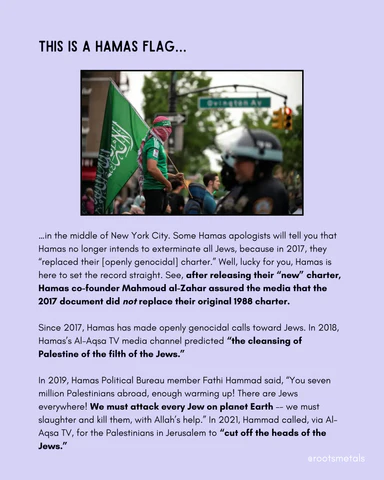
…in the middle of New York City. Some Hamas apologists will tell you that Hamas no longer intends to exterminate all Jews, because in 2017, they “replaced their [openly genocidal] charter.” Well, lucky for you, Hamas is here to set the record straight. See, after releasing their “new” charter, Hamas co-founder Mahmoud al-Zahar assured the media that the 2017 document did not replace their original 1988 charter.
Since 2017, Hamas has made openly genocidal calls toward Jews. In 2018, Hamas’s Al-Aqsa TV media channel predicted “the cleansing of Palestine of the filth of the Jews.”
In 2019, Hamas Political Bureau member Fathi Hammad said, “You seven million Palestinians abroad, enough warming up! There are Jews everywhere! We must attack every Jew on planet Earth –- we must slaughter and kill them, with Allah’s help.” In 2021, Hammad called, via Al-Aqsa TV, for the Palestinians in Jerusalem to “cut off the heads of the Jews.”
BTW, THIS IS ONE OF THE MANY THINGS THAT THE ORIGINAL HAMAS CHARTER SAYS...
"The Day of Judgement will not come about until Moslems fight the Jews (killing the Jews), when the Jew will hide behind stones and trees. The stones and trees will say O Moslems, O Abdulla, there is a Jew behind me, come and kill him. Only the Gharkad tree, (evidently a certain kind of tree) would not do that because it is one of the trees of the Jews." (related by al-Bukhari and Moslem)."
(Article 7)
Pretty explicitly antisemitic, wouldn’t you agree?
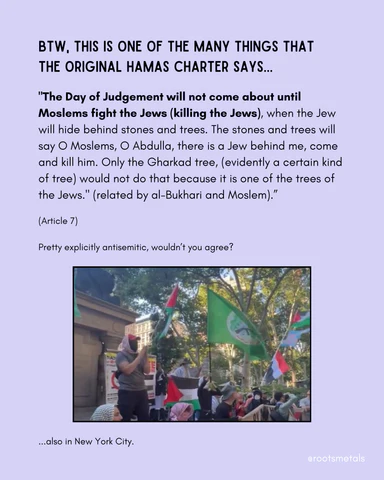
THIS IS A HEZBOLLAH FLAG (AND A HAMAS HEADBAND)..
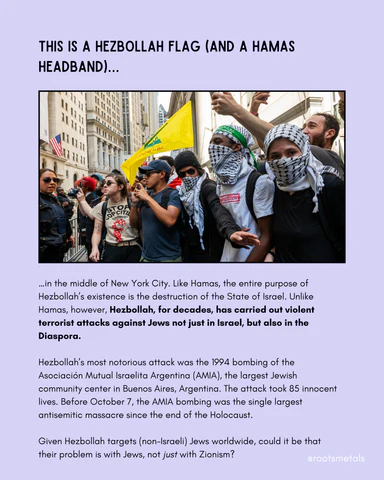
…in the middle of New York City. Like Hamas, the entire purpose of Hezbollah’s existence is the destruction of the State of Israel. Unlike Hamas, however, Hezbollah, for decades, has carried out violent terrorist attacks against Jews not just in Israel, but also in the Diaspora.
Hezbollah’s most notorious attack was the 1994 bombing of the Asociación Mutual Israelita Argentina (AMIA), the largest Jewish community center in Buenos Aires, Argentina. The attack took 85 innocent lives. Before October 7, the AMIA bombing was the single largest antisemitic massacre since the end of the Holocaust.
Given Hezbollah targets (non-Israeli) Jews worldwide, could it be that their problem is with Jews, not just with Zionism?
THIS, AGAIN, IS THE HEZBOLLAH FLAG...
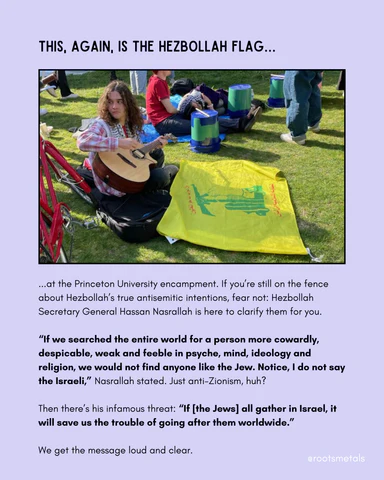
...at the Princeton University encampment. If you’re still on the fence about Hezbollah’s true antisemitic intentions, fear not: Hezbollah Secretary General Hassan Nasrallah is here to clarify them for you.
“If we searched the entire world for a person more cowardly, despicable, weak and feeble in psyche, mind, ideology and religion, we would not find anyone like the Jew. Notice, I do not say the Israeli,” Nasrallah stated. Just anti-Zionism, huh?
Then there’s his infamous threat: “If [the Jews] all gather in Israel, it will save us the trouble of going after them worldwide.”
We get the message loud and clear.
THIS IS "JEWISH" VOICE FOR PEACE, GLORIFYING THE HOUTHIS...

...using a photo that very clearly showcases the Houthi banner, which states, “God is the Greatest, Death to America, Death to Israel, A Curse Upon the Jews, Victory to Islam.”
“A Curse Upon the Jews” is pretty straightforward antisemitism, don’t you think?
The Houthis are also personally responsible for ethnically cleansing the last Jews out of Yemen. Just anti-Zionism, eh?
THIS IS A PALESTINIAN FLAG WITH VARIOUS PORTRAITS, INCLUDING THAT OF YAHYA SINWAR...
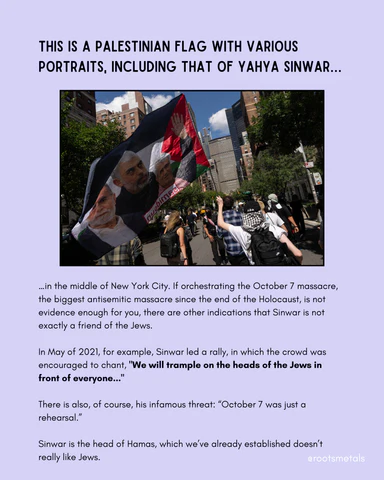
…in the middle of New York City. If orchestrating the October 7 massacre, the biggest antisemitic massacre since the end of the Holocaust, is not evidence enough for you, there are other indications that Sinwar is not exactly a friend of the Jews.
In May of 2021, for example, Sinwar led a rally, in which the crowd was encouraged to chant, "We will trample on the heads of the Jews in front of everyone..."
There is also, of course, his infamous threat: “October 7 was just a rehearsal.”
Sinwar is the head of Hamas, which we’ve already established doesn’t really like Jews.
THIS IS A PFLP FLAG (AND A HEZBOLLAH FLAG AND A HAMAS HEADBAND)...
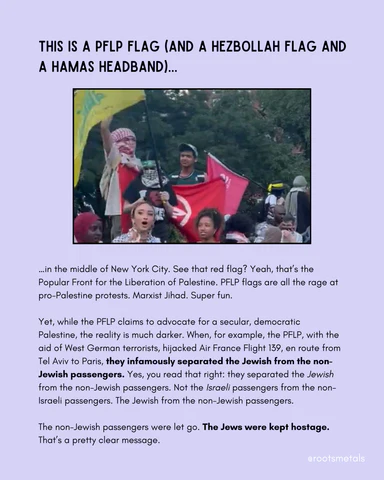
…in the middle of New York City. See that red flag? Yeah, that’s the Popular Front for the Liberation of Palestine. PFLP flags are all the rage at pro-Palestine protests. Marxist Jihad. Super fun.
Yet, while the PFLP claims to advocate for a secular, democratic Palestine, the reality is much darker. When, for example, the PFLP, with the aid of West German terrorists, hijacked Air France Flight 139, en route from Tel Aviv to Paris, they infamously separated the Jewish from the non-Jewish passengers.Yes, you read that right: they separated the Jewish from the non-Jewish passengers. Not the Israeli passengers from the non-Israeli passengers. The Jewish from the non-Jewish passengers.
The non-Jewish passengers were let go. The Jews were kept hostage. That’s a pretty clear message.
THIS IS A PFLP FLAG...
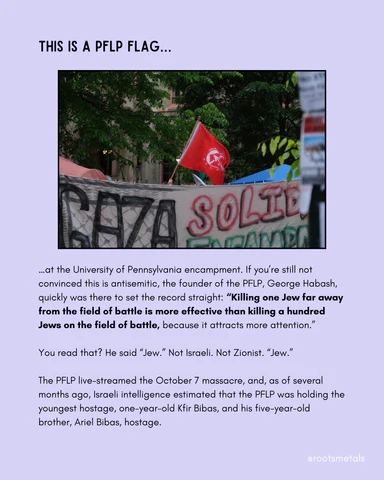
…at the University of Pennsylvania encampment. If you’re still not convinced this is antisemitic, the founder of the PFLP, George Habash, quickly was there to set the record straight: “Killing one Jew far away from the field of battle is more effective than killing a hundred Jews on the field of battle,because it attracts more attention.”
You read that? He said “Jew.” Not Israeli. Not Zionist. “Jew.”
The PFLP live-streamed the October 7 massacre, and, as of several months ago, Israeli intelligence estimated that the PFLP was holding the youngest hostage, one-year-old Kfir Bibas, and his five-year-old brother, Ariel Bibas, hostage.
THIS IS A PALESTINIAN ISLAMIC JIHAD FLAG (AND A PFLP FLAG AND A HAMAS FLAG)...
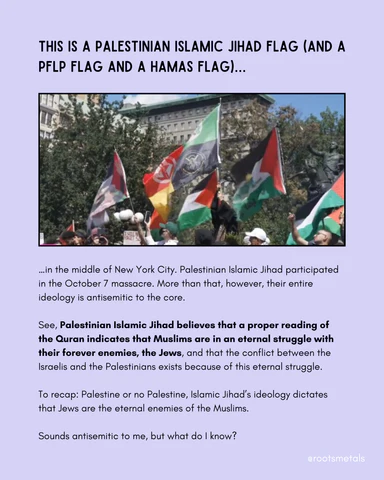
…in the middle of New York City. Palestinian Islamic Jihad participated in the October 7 massacre. More than that, however, their entire ideology is antisemitic to the core.
See, Palestinian Islamic Jihad believes that a proper reading of the Quran indicates that Muslims are in an eternal struggle with their forever enemies, the Jews, and that the conflict between the Israelis and the Palestinians exists because of this eternal struggle.
To recap: Palestine or no Palestine, Islamic Jihad’s ideology dictates that Jews are the eternal enemies of the Muslims.
Sounds antisemitic to me, but what do I know?
For a full bibliography of my sources, please head over to my Instagram and Patreon.
somehow we’ve normalized weekly antisemitic hate marches in broad daylight
145 notes
·
View notes
Text
Israel's communications minister is proposing emergency regulations that would allow police to arrest citizens and journalists who publish content deemed to "harm national morale".
Under Shlomo Karhi's proposal, those restrictions could be placed upon publications that have been used as a "base for enemy propaganda".
Journalists and other citizens could have their homes searched, property seized and could be placed under arrest for speech the government deems undesirable.
The proposal comes on the ninth day of fighting between Israel and Palestinian groups, which has killed at least 2,450 Palestinians in Gaza, including 724 children and 458 women. In the occupied West Bank and East Jerusalem, 56 people have been killed by Israeli fire. Meanwhile, at least 1,300 people have been killed in Israel.
Earlier on Sunday, Karhi said he was seeking a possible closure of Al Jazeera's local bureau, accusing the Qatari news station of pro-Hamas incitement and of exposing Israeli soldiers to potential attack from Gaza.
480 notes
·
View notes
Text

A small part of me mourns that there wasn't more time between AltMal's reconciliation and Al Mualim's death... would've afforded Altair some fun opportunities to sneak away to a certain Jerusalem bureau without worrying about Grandmaster duties.
#Assassin's Creed#AltMal#Altair ibn la Ahad#Malik Al Sayf#my art!#though I guess if he appointed Malik as right-hand man (excuse the pun) immediately...#then there'd be no need to sneak off to another city#he'd be right there... convenient
132 notes
·
View notes
Text
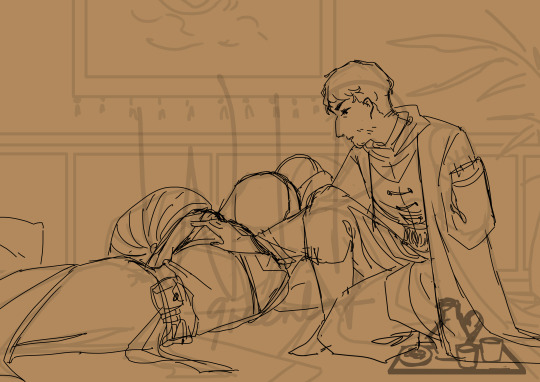
[WIP] altair wake up your rival is bringing you tea and dates
#had the worst vertigo today so this is indulgent sketch after i napped#idk when ill finish this bcs im still doing thesis so im just handing u the sketch for now#i hc altair to have chronic migraines so this is in reference to that#malik made him medicinal tea to feel better#the dates are to wash off the bitter tea taste#jerusalem bureau my beloved#this is the continuation of that bitter tea & oranges comic i made btw#altair gave malik orange. malik gave altair dates. gay behaviour everyone go home#altmal#asscreed#my art#assassins creed#assassin's creed#assassins creed 1#assassin's creed 1#altaïr ibn la'ahad#malik al sayf#altair ibn la'ahad
202 notes
·
View notes
Note
I'm sorry you probably have a lot of fic ideas but I need to get this sentence out before I lose my Staying Up After Midnight Nerves
Den Mother Desmond
Feel free to leave fic ideas, nonny. Even if I get busy, I’ll get to it sooner or later. XD
Not gonna lie, I was tempted to make this a continuation of Desmond Jerusalem Bureau’s Lighthouse since I did have him asking Malik what he wants for dinner last time but you used the word ‘den’ and that immediately reminded me of the Assassin dens in Assassin’s Creed Revelations soooo… have a confused Ezio.
==================================================
When Ezio saw the bright form running across the rooftops, he chased after it immediately. It wasn’t just curiosity…
It was like his entire body had moved on its own.
A few moments later, any questions he had were wiped off his mind.
Only one thought persisted.
‘Get it at all cost.’
He didn’t even know what ‘it’ was until he was closing in. At that point, it was as if all the Assassins in Constantinople were chasing it as well.
No.
Not it.
A man.
Desmond.
Or, at least, that was what he said his name was after Ezio caught him and asked his name.
Ezio… wasn’t entirely sure if he believed everything Desmond had told him once they were alone in an empty bedroom in the den in Galatea.
A part of Ezio didn’t want to believe it.
After everything he had seen, Desmond’s explanation did give him the answers he had been searching for all these times.
But it also left him…
A bit lost.
And that was the reason why he was unwilling to believe it.
Then Desmond kept running away and Ezio always found him.
It had gotten to the point that Yusuf talked to Ezio about it.
Desmond was too bright in their Eagle Vision. The Assassins would either get blinded or they would find it hard to focus whenever they used their Eagle Vision and Desmond was nearby.
And that was a dangerous risk that they would not afford here in Constantinople.
So… Ezio made a deal with Desmond.
The reason why Desmond kept running away was because he was trying to get all of Altaïr’s memory seals to get Altaïr’s Apple, hoping the Apple could tell him why he had been sent to this time.
Desmond insisted there must be a reason why he was here and Ezio had to stop himself from telling him that he was here for Ezio’s sake.
Ezio didn’t understand why he was so sure of that and he couldn’t just say that out loud. Not when it was clear that Desmond was pretending that he was alright.
But Ezio could see it in his eyes.
Desmond was also a bit lost just like him.
So Ezio promised him to find the remaining keys and they would travel to Masyaf together to get Altaïr’s Apple.
The look of grief in Desmond’s eyes when he said that made Ezio’s heart clench.
There was something in Masyaf that Desmond had lost and…
Well…
Ezio knew what it was almost immediately.
No.
Who it was.
If what Desmond said was true, if he truly did relive not just Ezio’s memories but Altaïr’s memories as well, then it was normal that Desmond would still grieve his death.
To Ezio, Altaïr has been dead for centuries.
But to Desmond…
Only a month or so has passed since he learned of Altaïr’s death if his stories were to be believed.
So Ezio asked Desmond to stay in the Assassin den in Galatea. It was the most fortified of the dens and it had the biggest space. He only hoped his time in the den would give Desmond some time to relax (or distract himself with something not life-threatening).
Ezio had hoped this would help Desmond with his grief as well. Not just to grieve for Altaïr’s death but to grieve over what had happened to him, to grieve for the life and the people he lost by being thrown into Ezio’s time.
What he did not expect was… the changes the den would go through because of Desmond’s boredom.
It started out small.
When Ezio returned to the den to resupply his bombs, he noticed that all of the bomb components have been organized. Each component was even already placed into specific pouches with the exact amount needed for one bomb. There were even instructions nailed to the side of the boxes, explaining the steps needed to make a bomb as well as a brief explanation of each component.
The Arabic handwriting was unfamiliar to Ezio but then he saw the Italian instructions written below it.
It was Ezio’s own handwriting.
He was sure of it.
Which meant… Desmond had written it.
He had noticed Desmond had the same handwriting as him and Ezio was sure he was missing a few key pieces of information about the Bleeding Effect but Ezio did understand that it was the Bleeding Effect that helped Desmond copy many of Ezio’s skills and techniques.
And, apparently, handwriting…
Ezio didn’t say a word about it though. If Desmond was keeping himself busy by organizing things in the den, he was free to do so.
Maybe he’d even find a way to organize the mess that Yusuf called the record room.
…
…
…
But Ezio did not expect it to escalate to this level.
Now, the Galatea den feels like… home.
The scent of a homemade meal in the air made Ezio’s mouth water. There was no more equipment or paperwork lying haphazardly on one of the tables or on the floor (and that one time that Ezio saw a sword stuck to the ceiling that Yusuf just waved off but offered no explanation to). The novices were busy preparing the tables with plates and cutlery while other novices were trying to finish their chores so they could eat as well.
The other Assassins seemed excited to eat as well, some even going as far as poking their head into the kitchen before quickly ducking away as if they had been caught.
Curiosity getting the better of him, Ezio walked inside the kitchen and Desmond immediately turned around and smiled at him as he said, “Welcome back, Ezio. Lunch’s just about ready.”
Ezio walked towards the table where a novice was chopping fruits that would probably be served together with whatever Desmond was cooking, “It smells wonderful, Desmond.”
Desmond turned around to focus on the cooking pot as he replied, “Thanks! I tried adding a few more herbs this time. Yusuf brought back some meat he got from the market and-”
“Ow!” Ezio shouted as Desmond quickly turned around and hit his hand by throwing one of the ladles near him. Ezio turned to stare at Desmond with a betrayed look on his face and it took all of Ezio’s willpower to not cower when he saw Desmond was now glaring at him.
“Have you washed your hands, Ezio?” Desmond asked.
“Of c-” Ezio’s mouth immediately closed when Desmond raised an eyebrow. Ezio sighed as he said, “I’ll wash them now.”
Desmond nodded before turning to face the pot once more. Ezio looked at the slice of fruit he was just about to take and blinked when the novice chopping fruits slid the plate filled with sliced fruits away from Ezio.
Ezio raised an eyebrow at the novice who began to glance between him and Desmond for a moment before finally staring at Ezio with an apologetic expression on his face as he slid the plate further away from Ezio.
Ezio sighed…
And went to wash his hands.
#this is also the same reason as to why altaïr chased desmond all over jerusalem#fortunately for altaïr#malik isn’t as carefree as yusuf#but yeah you can think that desmond is also the den mom in the jerusalem bureau#assassin's creed#desmond miles#ezio auditore#desmond den mom#ask and answer#teecup writes/has a plot
81 notes
·
View notes
Text
I headcannon that Desmond(and Altaïr) prefers to perch on boxes, furniture and such, instead of standing around. XD Like a proper bird. Malik definetly yelled at Altaïr to get off the counter in the Jerusalem bureau more than once and when Desmond perched in the warehouse for the first time, he nearly gave Shaun a heartattack. Even assassins forget to look up and a few centimers above someones head turns you invicible. XD
83 notes
·
View notes
Text
Updated version! ID written by @swosheep (it won't let me tag you oof)

ID 1: All images are of an Instagram post by letstalkpalestine2. The first one is titled "Lets Talk. What is Hamas? Answering the basic questions".

ID 2: the second image is titled "What Are Its Origins?". the body text reads: "Hamas is a Palestinian political party and armed resistance movement based in the besieged Gaza Strip. It emerged in 1987, at the start of the First Intifada, as a reaction to intensifying israeli violence and as a religious alternative to the secular Palestinian parties that dominated the scene at the time. Hamas was originally a branch of Egypt's Muslim Brotherhood but later cut ties with it and became an independent group. In 1992, Hamas formed a military wing called the Izz al-Din al-Qassam Brigades to resist the israeli occupation. The Brigades carried out several significant operations against Israel during the Second Intifada, which established Hamas as a leading force in the Palestinian resistance."
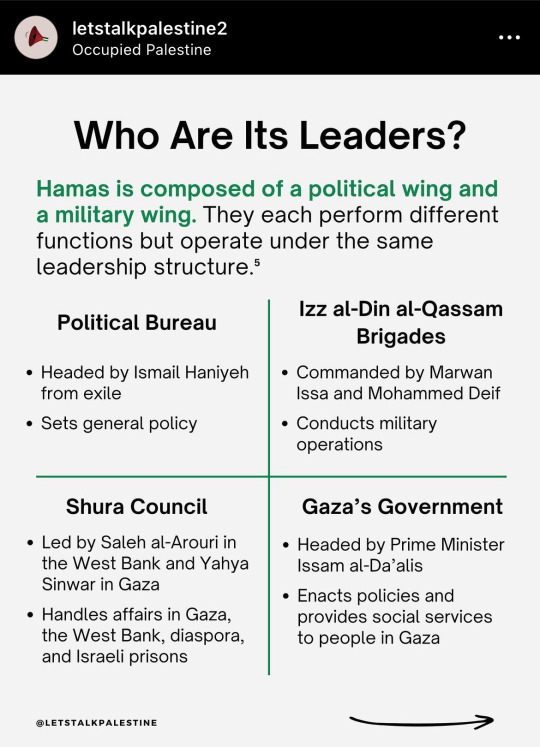
ID 3: the third image is titled "Who Are Its Leaders?". The body text reads: "Hamas is composed of a political wing and a military wing. They each perform different functions but operate under the same leadership structure." There is a grid with four sections. The first section is titled "Political Bureau", and reads: "- Headed by Ismail Haniyeh from exile - Sets general policy". The second section is titled: "Izz al-Din al-Qassam Brigades" and reads: "- Commanded by Marwan Issa and Mohammed Deif - Conducts military operations". The third section is titled: "Shura Council" and reads: "- Led by Saleh al-Arouri in the West Bank and Yahya Sinwar in Gaza - Handles affairs in Gaza, the West Bank, diaspora, and israeli prisons". The fourth section is titled: "Gaza Government" and reads: "- Headed by Prime Minister Issam al-Da'alis - Enacts policies and provides social services to people in Gaza".

ID 4: The fourth image is titled: "What Does Hamas Want?" The body text reads: "Its 2017 charter states that its current political program is to: - Implement the right of return for all Palestinian refugees; - Establish a temporary Palestinian state along the 1967 borders (the West Bank, including East Jerusalem, and the Gaza Strip) and arrange a long-term truce with israel. Hamas considers the establishment of a Palestinian state on the '67 borders as a temporary step. It refuses to recognize israel's legitimacy and advocates for the 'full and complete liberation of Palestine, from the river to the sea.' Hamas's 2017 charter states that its struggle is against the israeli state and the Zionist movement due to their occupation of Palestine, not Jewish people, and criticizes israel for associating its actions with Jewish values. Hamas's stated goals for its current operation are to - Free the thousands of Palestinian prisoners held by israel, - End the Gaza blockade, - End the status quo where Israel continues its occupation without cost".

ID 5: the fifth image is titled: "Does Hamas Control Gaza?". The body text reads: "Not really. Hamas administers local affairs, while israel controls much of Gaza from the outside through its blockade. israel forcibly controls: - Airspace, - Sea access, - Movement of all goods and people in and out, - Telecoms networks, - Electromagnetic sphere, - Tax distribution, - Population registry, - Water, - Electricity and fuel. Hamas began governing Gaza in 2007, and has since managed: - Healthcare, - Education, - Infrastructure, - Social welfare, - Law enforcement, - Public employment. Hamas is not a sovereign government. israel's blockade prevents Palestinians from independently exercising sovereignty over Gaza's population, development, and economy."
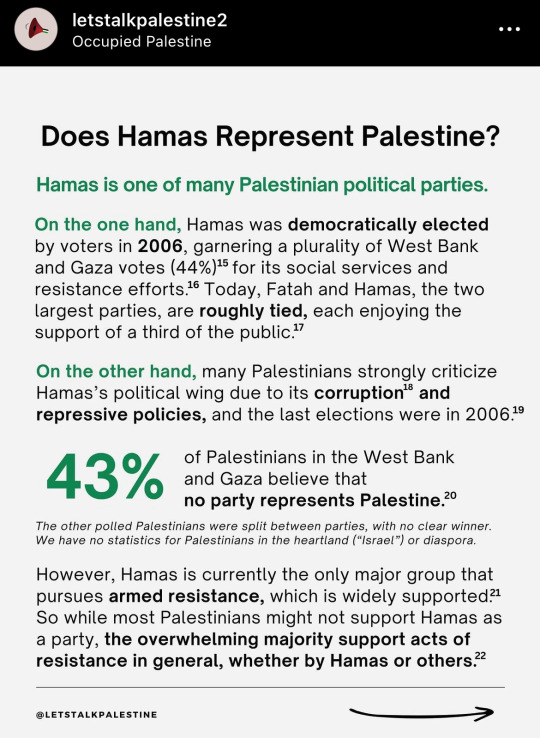
ID 6: The sixth image is titled "Does Hamas Represent Palestine?" The body text reads: "Hamas is one of many Palestinian political parties. On the one hand, Hamas was democratically elected by voters in 2006, garnering a plurality of West Bank and Gaza votes (44%) for its social services and resistance efforts. Today. Fatah and Hamas, the two largest parties, are roughly tied, each enjoying the support of a third of the public. On the other hand, many Palestinians strongly criticize Hamas's political wing due to its corruption and repressive policies, and the last elections were in 2006. 43% of Palestinians in the West Bank and Gaza believe that no party represents Palestine. The other polled Palestinians were split between parties, with no clear winner. We have no statistics for Palestinians in the heartland ("israel") or diaspora. However, Hamas is currently the only major group that pursues armed resistance, which is widely supported. So while most Palestinians might not support Hamas as a party, the overwhelming majority support acts of resistance in general, whether by Hamas or others."

ID 7: the seventh image is titled "Is Hamas a Proxy of Iran?". The body text reads: "No. Hamas is an independent group with a political program and military strategy distinct from Iran. Hamas and Iran are strategic allies, meaning that while Iran provides Hamas with significant financial, military, and political support, Hamas does not act or operate on behalf of Iran. It makes decisions based on its own interests, and independently manages relations with countries like Turkey, Qatar, and Egypt. For example: In 2012, Hamas cut ties with Syria because it opposed the Assad regime's violent crackdown on protesters. It took this decision despite angering Iran, a close ally of Assad. Regarding Operation Al-Aqsa Flood, even israeli officials admit there is no evidence that Iran was in any way involved. Iran was actually surprised by it. Hamas independently coordinated and launched the operation to achieve its own goals."

ID 8: The eighth image is titled "Does Hamas Negotiate with Israel?". The body text reads: "Hamas views armed struggle as only one of several tools to end apartheid & occupation, such as diplomacy. In 2006, in an op-ed for The Guardian, Hamas chairman Ismail Haniyeh revealed that israel refused Hamas's proposal for a truce. In 2008, former Hamas chief Khaled Meshal offered a 10-year truce in exchange for a sovereign Palestinian state along the 1967 borders with Jerusalem as its capital." israel rejected the proposal. In 2016, Hamas offered a long-term truce in exchange for simply ending the Gaza Blockade. israel rejected it. In 2018, Haniyeh revived this offer by sending a handwritten letter in Hebrew to Israeli Prime Minister Netanyahu. But israel rejected it again. israel repeatedly rejected Hamas's diplomatic initiatives because israel saw no reason to end the oppressive status quo, which it believed gave it power & privileges over Palestinians with minimal downsides. israel's benefits outweighed the costs. Hamas is trying to change that."

ID 9: the ninth image is titled "Is Hamas Risking Palestinian Lives?". The body text reads: "Westerners often accuse Hamas of risking Palestinian lives by fighting apartheid and thus inviting a deadly israeli crackdown. But the reality is that israel's blockade is slowly killing everyone in Gaza. [quote] 'We have paid a high cost in lives in this conflict. But if that's the price for long-term changes - breaking the siege and obtaining freedom - it's one many of us feel we have no choice but to swallow.' [unquote] -Haytham Besalso, civil engineer from Gaza, 2014. [quote] 'We are bleeding here, anyway [..] The Gaza Blockade crushes any opportunity for peace.' [unquote] -Ismail, anonymous journalist from Gaza, 2021. The argument that Hamas is responsible for israel's killing of Palestinians is malicious. It blames the victims for resisting apartheid and absolves the oppressors of responsibility, treating the mass killing of children as a 'normal' israeli response."

ID 10: the tenth image says: "You don't need to support Hamas as a political party to support Palestine. Most Palestinians don't support it as a party. But Hamas is an effective political player in the struggle against apartheid, oppression, and colonization. It has achieved remarkable success in preventing israeli violence in Jerusalem and freeing Palestinian hostages abducted by israel. Hamas has institutions, ministries, student movements, and women's movements, and employs thousands of doctors, teachers, judges, and aid workers. It is part of the fabric of Palestinian society. So while you don't need to support Hamas to support Palestine, you cannot oppose oppression without supporting the resistance to it. You cannot support freedom while supporting israeli efforts to wipe out those who fight for that freedom, including Hamas, to leave Palestinians defenc Pales".
End ID.
the original caption states that @/LetsTalkPalestine2 does not endorse any specific party, including Hamas, and that the last word on the last slide should be *defenseless.
#resources#reaux speaks#bipoc#free palestine#palestine#free gaza#gaza#west bank#genocide#ethnic cleansing#israel#ceasefire#hamas#instagram
190 notes
·
View notes
Text

281 notes
·
View notes